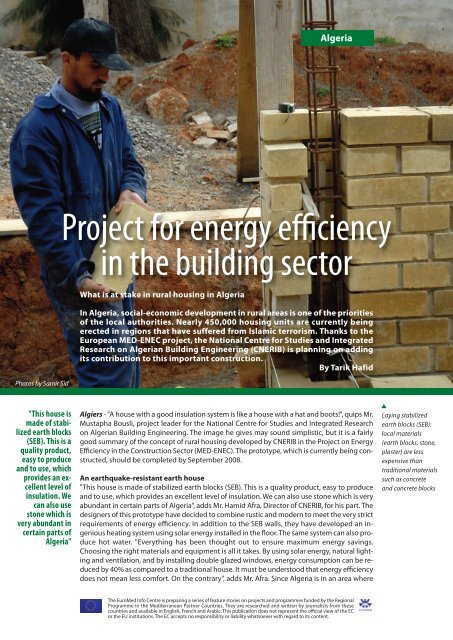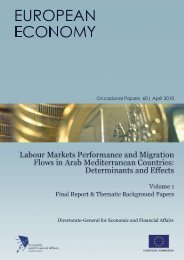MedEnec Algeria.pdf - EU Neighbourhood Info Centre
MedEnec Algeria.pdf - EU Neighbourhood Info Centre
MedEnec Algeria.pdf - EU Neighbourhood Info Centre
Create successful ePaper yourself
Turn your PDF publications into a flip-book with our unique Google optimized e-Paper software.
<strong>Algeria</strong>Project for energy efficiencyin the building sectorPhotos by Samir SidWhat is at stake in rural housing in <strong>Algeria</strong>In <strong>Algeria</strong>, social-economic development in rural areas is one of the prioritiesof the local authorities. Nearly 450,000 housing units are currently beingerected in regions that have suffered from Islamic terrorism. Thanks to theEuropean MED-ENEC project, the National <strong>Centre</strong> for Studies and IntegratedResearch on <strong>Algeria</strong>n Building Engineering (CNERIB) is planning on addingits contribution to this important construction.By Tarik Hafid"This house ismade of stabilizedearth blocks(SEB). This is aquality product,easy to produceand to use, whichprovides an excellentlevel ofinsulation. Wecan also usestone which isvery abundant incertain parts of<strong>Algeria</strong>"Algiers - "A house with a good insulation system is like a house with a hat and boots!", quips Mr.Mustapha Bousli, project leader for the National <strong>Centre</strong> for Studies and Integrated Researchon <strong>Algeria</strong>n Building Engineering. The image he gives may sound simplistic, but it is a fairlygood summary of the concept of rural housing developed by CNERIB in the Project on EnergyEfficiency in the Construction Sector (MED-ENEC). The prototype, which is currently being constructed,should be completed by September 2008.An earthquake-resistant earth house"This house is made of stabilized earth blocks (SEB). This is a quality product, easy to produceand to use, which provides an excellent level of insulation. We can also use stone which is veryabundant in certain parts of <strong>Algeria</strong>", adds Mr. Hamid Afra, Director of CNERIB, for his part. Thedesigners of this prototype have decided to combine rustic and modern to meet the very strictrequirements of energy efficiency. In addition to the SEB walls, they have developed an ingeniousheating system using solar energy installed in the floor. The same system can also producehot water. "Everything has been thought out to ensure maximum energy savings.Choosing the right materials and equipment is all it takes. By using solar energy, natural lightingand ventilation, and by installing double glazed windows, energy consumption can be reducedby 40% as compared to a traditional house. It must be understood that energy efficiencydoes not mean less comfort. On the contrary", adds Mr. Afra. Since <strong>Algeria</strong> is in an area where▼Laying stabilizedearth blocks (SEB):local materials(earth blocks, stone,plaster) are lessexpensive thantraditional materialssuch as concreteand concrete blocksThe EuroMed <strong>Info</strong> <strong>Centre</strong> is preparing a series of feature stories on projects and programmes funded by the RegionalProgramme in the Mediterranean Partner Countries. They are researched and written by journalists from thesecountries and available in English, French and Arabic. This publication does not represent the official view of the ECor the <strong>EU</strong> institutions. The EC accepts no responsibility or liability whatsoever with regard to its content.
FEATURE STORy Νο12 - 2008Project for energy efficiency in the building sectorMED-ENEC - ENERgy EFFICIENCyReconstructionteam: the prototypeshould becompleted bySeptember 2008▼By using solar energy,naturallighting and ventilation,and byinstalling doubleglazed windows,energy consumptioncan be reducedby 40% ascompared to atraditional houseHamid Afra, Directorof CNERIB: "It is ourobjective to promotethe use of localbuilding materials"Since 2005, <strong>Algeria</strong>has launcheda programme forthe constructionof one millionhousing units.Nearly half ofthis programme– 450,000 units –is devoted tohousing in ruralareas▼earthquakes are frequent, researchersat CNERIB have developeda system ofload-bearing masonry wallsreinforced by ties. In otherwords, the building is notsupported by pillars andbeams, but by thick, loadbearingwalls.Concrete applicationof researchIt is helpful to specify that thisprototype was chosen for acompetition launched by theMED-ENEC project in 2006.The CNERIB project was theseventh of 10 projects retained.The first place went toan Israeli project.To be accepted, the housingconcept had to meet verystrict criteria such as the potentialfor dissemination, thequality of the energy concept,the economic resultsand the environmental benefit.The projects received financialbacking of 100,000euros from the MED-ENECproject. "The CNERIB hasdone many research projectsin ecological, energy-efficienthousing. Participating in thiscompetition is beneficial onseveral counts since it givesus an opportunity to implementconcrete applicationsof all our skills and our research",explains Mr. Afra.The National <strong>Centre</strong> forStudies and IntegratedResearch on <strong>Algeria</strong>nBuilding EngineeringThe National <strong>Centre</strong> forStudies and Integrated Researchon <strong>Algeria</strong>n BuildingEngineering (CNERIB)was created in 1978. It is apublic scientific and technologicalinstitution thatreports to the <strong>Algeria</strong>nMinistry of Housing andUrban Planning. It is locatedin Souidania, a townwest of Algiers, and it proposestechnical assistance,expertise and training toboth public and privateoperators. The staff consistsessentially of researchersand qualifiedtechnicians.Source CNERIBStemming ruraldepopulationBut CNERIB’s contribution isnot limited to simply participating.The <strong>Centre</strong> plans tocapitalize on this experience.In fact, since 2005, <strong>Algeria</strong> haslaunched a programme forthe construction of one millionhousing units. Nearly half“The buildingconcept that weare developing isbased essentiallyon local products.The production ofstabilized earthblocks is a relativelysimple operationthat doesnot require largeresources.”says the projectleaderW W W . E u R o M E D I N f o . E u2
FEATURE STORy Νο12 - 2008Project for energy efficiency in the building sectorMED-ENEC - ENERgy EFFICIENCy▼View of the heatingsystem under thefloor, powered bysolar energySystem of loadbearingmasonryreinforced by ties▼of this programme – 450,000units – is devoted to housingin rural areas. "This is a realchallenge that we must meet.Of course, the State is committedto constructing hundredsof thousands ofhousing units, but their ownersmust also benefit frommaximum comfort", indicatesthe director of CNERIB. For afew years now, the <strong>Algeria</strong>nauthorities have made developmentof rural housing oneof their priorities in order to"settle" the population. In the90s, nearly a million peopleleft the countryside to flee Islamicterrorism. This massivemovement has had disastrousrepercussions on <strong>Algeria</strong>nsociety as a whole. Nowwith the decline of terrorism,the trend has been turningaround for a few years. Butproviding a roof is notenough – above all, ruralpopulations must be able tolive decently.Creating wealthMr. Mustapha Bousli feelsthat the project initiated byCNERIB can be a factor ofeconomic development inrural areas. "The buildingconcept that we are developingis based essentially onlocal products. The productionof stabilized earth blocksis a relatively simple operationthat does not requirelarge resources. All it takes isa mixer and a press for SEB,says the project leader. He isopenly optimistic. "We will beable to create enterprises forproducing the materials, aswell as others specialized inbuilding housing in ruralareas". Mr. Bousli’s dreamseems to be coming true. Themasons in charge of buildinga prototype in the centre regionhave decided to investin this niche. To start up, theyare considering asking for financialaid from the State. "Imust say this is very encouraging.These young peoplehave understood the advantagesof our approach. Andwe plan to accompany themin their initiative", announcesMr. Hamid Afra.The future entrepreneurs willeven be entitled to a certificateproving that they participatedin the MED-ENECadventure. ■Since <strong>Algeria</strong> is inan area whereearthquakes arefrequent,researchers atCNERIB havedeveloped asystem of loadbearingmasonrywalls reinforcedby ties. In otherwords, thebuilding is notsupported bypillars andbeams, but bythick, loadbearingwallsName: MED-ENEC - Energy Efficiency in the Construction SectorBudget: 4 million euros (MEDA)Duration: 2005-2008.Participating Mediterranean Partner Countries: <strong>Algeria</strong>, Egypt,Israel, Jordan, Lebanon, Morocco, Palestinian Authority, Syria,Tunisia, TurkeyMED-ENEC targets stimulating energy measures and using solarenergy in the construction sector. The project is a major instrumentfor designing and implementing cooperative projects between MEDAcountries and <strong>EU</strong> Member States and between the MEDA countriesthemselves.Website: www.med-enec.comThe EuroMed <strong>Info</strong><strong>Centre</strong> is an <strong>EU</strong>-fundedRegional <strong>Info</strong>rmation and Communicationproject on the Europeanand Mediterraneanpartnership. Its main aim is tomake the MEDA Regional Programmeand the <strong>EU</strong>'s partnershipwith the Mediterraneanmore visible.Contact: EuroMed <strong>Info</strong> <strong>Centre</strong>,Rue D'Egmont 15 1000BrusselsTel: +32 2 513 7125Fax: +32 2 230 2513www.euromedinfo.euW W W . E u R o M E D I N f o . E u3

















